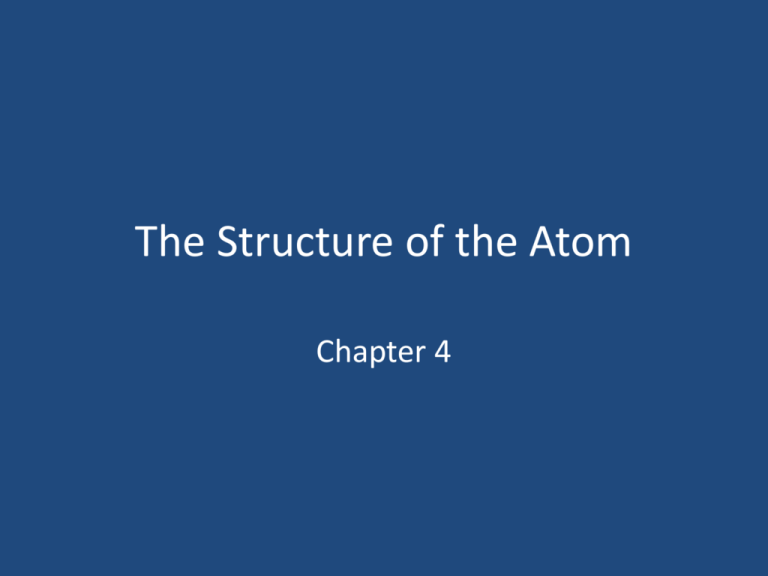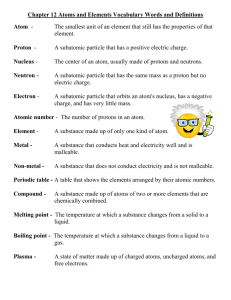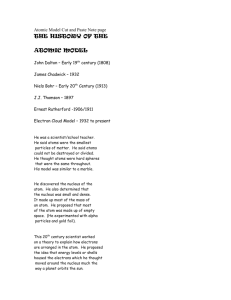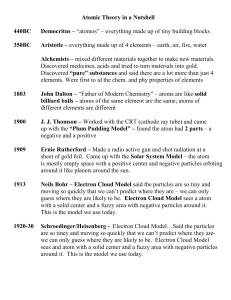Ch. 4 ppt w/notes
advertisement

The Structure of the Atom Chapter 4 4.1 Early Theories of Matter The Philosophers • Speculated about the nature of matter • Many concluded that matter was composed of earth, water, air, and fire 4.1 Early Theories of Matter Democritus (460-370 BC) • First to propose the idea that matter was not infinitely divisible • “atomos” • • • • Atoms composed of empty space through which atoms move Atoms are solid, homogeneous, indestructible, and indivisible. Different kinds of atoms have different sizes and shapes The differing properties of matter are due to the size, shape, and movement of atoms. • Apparent changes in matter results from changes in the groupings of atoms and not from changes in the atoms themselves. 4.1 Early Theories of Matter Aristotle (384-322 BC) • Influential Greek philosopher • Rejected Democritus’ ideas • Thought matter was continuous • Aristotle’s influence so great and the science so primitive (lacking!) his denial for the existence of atoms went largely unchallenged for 2000 years. 4.1 Early Theories of Matter John Dalton (1766-1844) • Revived and revised Democritus’s ideas based on research. ATOMIC THEORY (1803) 1. All matter is composed of extremely small particles called atoms. 2. All atoms of a given element are identical, having the same size, mass, and chemical properties. Atoms of a specific element are different from those of any other element. 3. Atoms cannot be created, divided into smaller particles, or destroyed. 4. Different atoms combine in simply whole-number ratios to form compounds. 5. In a chemical reaction, atoms are separated, combined, or rearranged. 4.1 Early Theories of Matter John Dalton cont. • Studied numerous chemical reactions… and determined mass ratios of the elements involved in the reactions. Atoms explain the Law of Conservation of Mass! Dalton has three errors in his theory: 1. Atoms ARE divisible. 2. Atoms of the same elements are not all identical. 3. 4.1 Early Theories of Matter Defining the Atom Atom – the smallest particle of an element that still retains the properties of that element Can see them with a scanning tunneling microscope! 4.2 Subatomic Particles and the Nuclear Atom • Charles Goodyear’s discovery of rubber vulcanization was an accident just like many scientific discoveries! 4.2 Subatomic Particles and the Nuclear Atom • Partially evacuated tube • Pass electricity through tube • Metal electrodes at each end • William Crookes • Light-producing coating at end • “Cathode ray” • TV’s use cathode rays! 4.2 Subatomic Particles and the Nuclear Atom 4.2 Subatomic Particles and the Nuclear Atom • By the end of the 1800’s… 1. Cathode Rays were actually a stream of charged particles. 2. The particles carried a negative charge (actual charge not known). 4.2 Subatomic Particles and the Nuclear Atom They determined that the ray’s negative particles were found in all forms of matter because… 1. Changing the type of electrode … 2. Varying the gas in the tube… did not affect the cathode ray produced Fig. 4-8 Multiple Experiments helped determine the properties of cathode rays. Observation Interpretation A. B. C. i.e. Electrons were discovered! 4.2 Subatomic Particles and the Nuclear Atom JJ Thomson (1856-1940) 1890’s – completed a series of experiments that determined the charge-to-mass ratio of the electron. - Compared…to other known ratios. Concluded that the mass of the charged particle was much less than that of a hydrogen atom. - SHOCKING! Because… there are particles smaller than atoms! Atoms are divisible! 4.2 Subatomic Particles and the Nuclear Atom Robert Milikan (1868-1953) 1909 – determined the charge of the electron Within 1% of currently accepted value! Knowing JJ’s charge-to-mass ratio he calc’d mass of an electron 9.2 x 10-28 g = __1__ mass of H atom 1840 4.2 Subatomic Particles and the Nuclear Atom 4.2 Subatomic Particles and the Nuclear Atom Some questions Thomson’s and Milikan’s work raised… 1. If electrons are part of all matter an they possess a negative charge, how is it that all matter is neutral? 2. If the mass of an electron is so extremely small, what accounts for the rest of the mass in a typical atom? 4.2 Subatomic Particles and the Nuclear Atom JJ Thomson’s Model: Fig. 4-9 Credited with discovery of the electron due to his ratio. 4.2 Subatomic Particles and the Nuclear Atom The Nuclear Atom – Ernest Rutherford (1871-1937) Gold Foil Expt. 1911 4.2 Subatomic Particles and the Nuclear Atom Rutherford predicts the alpha particles go straight through because JJ’s model has diffuse positive charge. Fig. 4-10 Expected Results 4.2 Subatomic Particles and the Nuclear Atom Fig. 4-11 Set-up & Results Diffuse positive charge cannot explain deflections at large angles. Fig. 4-10 Expected Results Fig. 4-12 Explanation of Results Observation 1) 2) Interpretation 4.2 Subatomic Particles and the Nuclear Atom Rutherford’s Model: • Nucleus at center (positive) • Mostly empty space in which electrons travel • Atom diameter is two football fields; nucleus is a nickel! Completing the atom – The discovery of protons and neutrons 1920 – Rutherford discovers the proton 1932 – James Chadwick discovers the neutron Atom Basics: nucleus – 99.97% atom’s mass protons = electrons (atoms are neutral) Table 4-1: Properties of Subatomic Particles Particle Symbo Location Relative l electrical charge Electron e- Proton p+ Neutron no Outside nucleus In nucleus In nucleus Actual Charge (C) Relative mass Actual Mass -1 1/1840 +1 1 9.11 x 10-28 1.673 x 10-24 0 1 1.675 x 10-24





